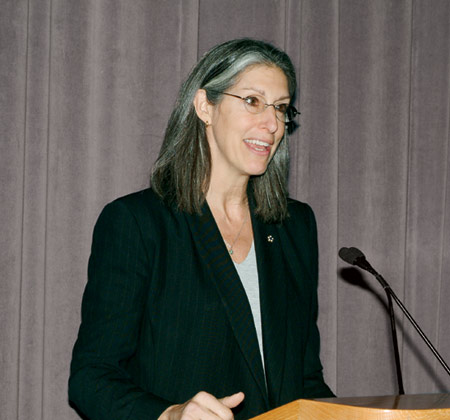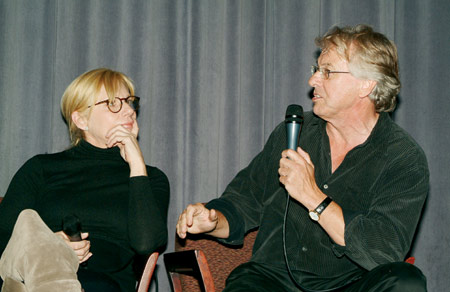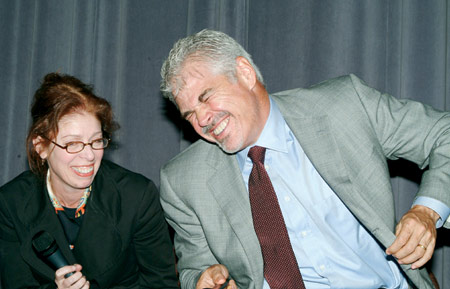Deborah Nadoolman, John Landis, Judianna Makovsky, Gary Ross, Ellen Mirojnick and Paul Verhoeven
"Costume design is a more integral part of the filmmaking process than just the look. With costume design you're dealing with the establishment of character," said Gary Ross, director of the period films Pleasantville and Seabiscuit, during the November 19 panel discussion presented by the DGA and the Costume Designers Guild in DGA Theatre 2, Bringing Characters to Life: Costume Design from Script to Screen. "In a period movie so much more is established in the costume and somewhat less in the production design than one would think. What you're looking at are the people and the details in the foreground. They draw your eye and establish the authenticity."
Costume Designers Guild President Deborah Nadoolman moderated the panel discussion after she presented film clips spotlighting costumes in the panelists' movies. The panel featured three directors and the costume designer with whom each director continually collaborates: Ross and Judianna Makovsky; Paul Verhoeven (Basic Instinct, Starship Troopers) and Ellen Mirojnick; and John Landis (Animal House, Trading Places) and Nadoolman. She is also married to Landis.

Deborah Nadoolman
Costume design, all of the panelists agreed, begins with a conversation between the director and the costumer designer. "I visualize a lot of storyboards and how people move and how the camera moves, but exactly how these people will look, that is mostly decided when I sit with Ellen," Verhoeven said. "Then she comes up with the ideas. Most of the time I think it's great and sometimes I think, 'oh no, I don't want that.' The important aspect to filmmaking is that you are relying, at least I do, very strongly on the heads of departments. I think they're all better at their departments than I am. My main talent is in directing, not in editing or music and certainly not costume. If you would ask me at the beginning, 'what will be the costumes?' I couldn't tell you."
"With Basic Instinct, it was of a particular genre, and what I love to do with Paul in the conversations is suss out the overall feeling of the movie that he wants to achieve, more so than what's on the script," Mirojnick said. "Then there are the characters, the palette, the textures and specific dramatic points and structure that need to be achieved while those characters are telling that story. We'll always discuss and suggest [ideas] by representation, whether it be a sketch, the garment, a fabric. Working with Paul is always about raising the level of risk, not just to be audacious, [but] within the structure of the story.
"In the first scene of Basic Instinct, [Sharon Stone's] white dress took me completely by surprise," Verhoeven said. "When Ellen said to me, 'she's in white,' I said, 'in white?' But ultimately it was a great touch. That's what I thought was courageous, to go completely in a direction that I had not foreseen. If you start to know the people you work with, then you become confident that even if you disagree they might be right."

Ellen Mironjnick and Paul Verhoeven
Judianna [Makovsky] sees her responsibility to be basically we'll look at anything that can talk, and that extends to hair and makeup, which I'm mercifully thankful for," said Gary Ross. "That extends to what extras look like. Nobody leaves the tent in the morning until they've been approved of by her. I so rely on that obsessive amount of detail; it just gives me a feeling of safety every morning."
Landis and Nadoolman's dialogue on costume design dates back to Kentucky Fried Movie (1977). It was the wit of her costumes, produced with "no money," that earned his respect. "Deborah brings to my movies a level of wit in the costumes and design of the characters that I'm very lucky to have. They're very smart costumes," he said.

Makovsky and Ross
"Generally speaking, when we're home, we're home but when we're working we're working and we discuss everything," Nadoolman said. "John is very good at articulating what he hopes to see. I rarely second-guess him. I would go broke."
"My process with Deborah is basically 'that's great, thank you very much' or 'I hate it, no,' " Landis said. "We don't really fight that much because it's not worth it.
"Trading Places had brilliant costumes, my favorite contemporary costumes that Deborah did, but because they were contemporary nobody saw them. They'd say, 'well, they're wearing suits.' When I was making the movie I was so grateful, saying, 'these are so great.' It's so amazing the difference between good costume work and mediocre costume work. What's fascinating to me about costume design is that you don't notice the good work, but you really see the bad work."